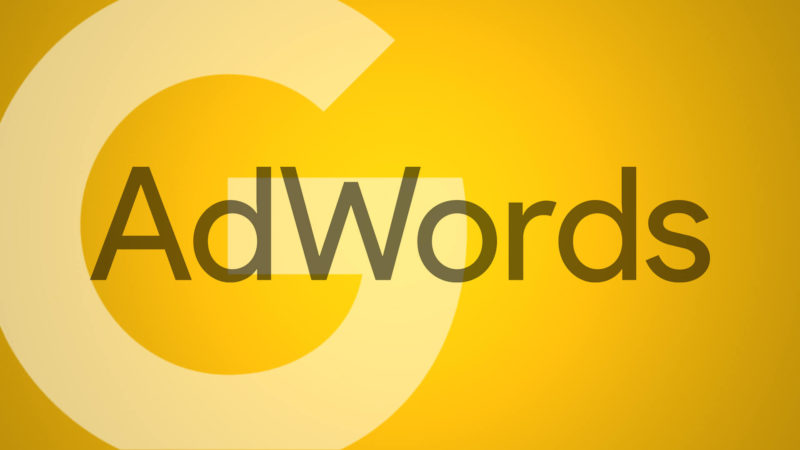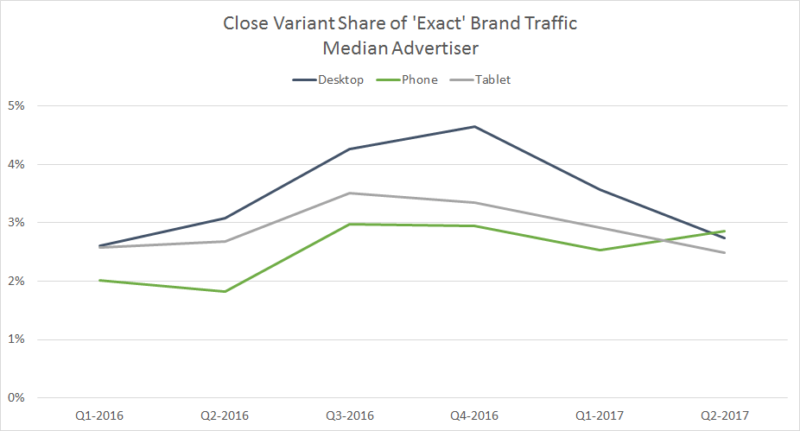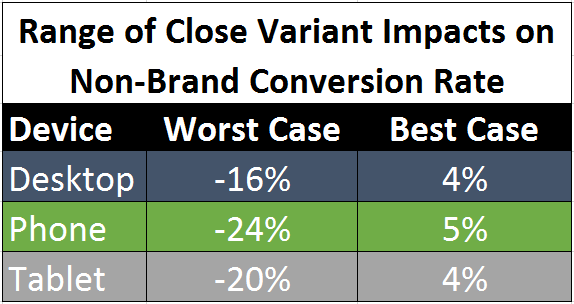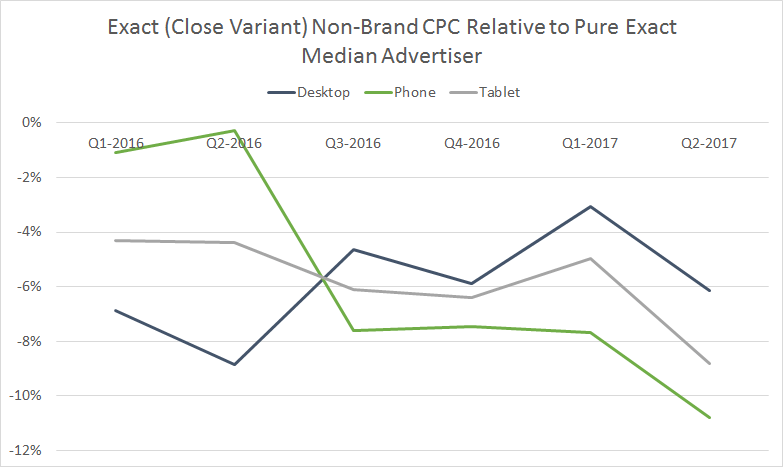Early performance results from Google’s update to close variants
What impact has Google's latest update to close variants had on paid search performance? Columnist Andy Taylor reviews the data.

Back in March, Google began expanding its definition of what constitutes a close variant exact match, a change they expected to roll out “over the coming months.”
At last Tuesday’s “Mad Scientists of Paid Search” session at SMX Advanced, I presented the latest Merkle data on what kind of impact we’ve seen so far. Here I’ll walk through some of the data presented there and explain what it means for advertisers.
Close variant traffic share steady so far
Taking a look at the share of all “exact” and “exact (close variant)” non-brand traffic attributed to close variants for a set of Merkle advertisers, we find that it has remained relatively the same so far in Q2 compared to what we’ve observed since the beginning of 2016 across all three device types for the median brand.
I measured close variant traffic in this way because it gives a sense of what share of traffic would be attributed to close variants if every single keyword in an account were set to exact match. Thus, this method helps to minimize the effect of some advertisers relying more heavily on phrase and broad match types than others, which would heavily impact metrics like the overall share of search traffic coming from “exact (close variants).”
Looking at this same measure for brand traffic, close variants account for a much smaller share of exact traffic, and there has been no obvious movement yet as a result of Google’s update.
So it appears that the updates to the definition of what constitutes a “close variant” haven’t affected how much traffic these matches drive just yet, though again Google mentioned a timeline of “over the next several months.” But what about the conversion rate of close variants relative to pure exact?
Close variant conversion rate holds steady relative to pure exact
Comparing the conversion rate of exact close variant non-brand traffic to pure exact, relative performance has remained roughly the same on desktop and tablet devices since the announcement. Tablet relative performance sank to its lowest level since the beginning of 2016, but this device type accounts for a very small share of overall traffic.
Thus, the update has not yet significantly impacted the relative conversion rate of close variants to pure exact match or the share of traffic coming from close variants.
Let’s take a step back from attempting to measure the impact of the update and focus on what close variants mean for performance right now.
Overall impact of close variants on exact match conversion rate
For the median advertiser, close variants are bringing down the total conversion rate of non-brand exact match traffic between 3 percent and 5 percent in Q2.
However, the impact ranges widely across the sample set studied, and some advertisers see far worse results. On the other hand, some brands actually see a slightly higher overall non-brand conversion rate when factoring in close variants.
For brands that see significantly negative impacts to non-brand exact match conversion rate as a result of mandatory close variants, it’s obviously important to stay active in mining search query reports to identify potential keyword negatives. On the other side of the coin, those advertisers seeing little to slightly positive impacts on conversion rate overall don’t have to be quite as concerned over mandatory close variants, though close variant matches can still cause inefficiencies for any specific keyword within an account and still need to be monitored.
Looking at how much close variants impact the conversion rate of brand keywords, there’s actually zero percent impact for the median advertiser across all three device types. This is due to close variants accounting for just 2-3 percent of all brand “exact” traffic for the median advertiser in Q2, as well as close variant conversion rate coming in very nearly the same as true exact conversion rate for brand keywords.
While the median difference in non-brand conversion rate for exact match queries due to close variants might seem relatively minor, even this level of negative impact can easily turn off valuable traffic.
How close variants can ‘turn off’ traffic
Imagine an exact match keyword that requires a bid of $1.50 in order to show on the first page of results, and an advertiser that needs a 3:1 return on ad spend in order to afford to continue getting traffic on that keyword. That means that the expected revenue per click needs to be at least $4.50, lest the keyword fall off the first page and stop getting traffic all together.
Now assume that pure exact match queries make up 90 percent of all traffic for the keyword and produce revenue per click of $4.50 exactly. The other 10 percent of traffic comes from close variants that produce revenue per click of $3.15.
In aggregate, the expected revenue per click of traffic on this keyword falls below the required $4.50 to warrant a bid high enough for the first page. The only way to avoid this is meticulous management from the advertiser in pruning close variant matches with negative keywords.
Even for those brands which might see even a slightly higher overall non-brand conversion rate for non-brand exact match as a result of close variants, these inefficiencies can exist for any given keyword. Thus, all brands need to be evaluating the close variant matches occurring in accounts in order to limit the adverse effects of these inefficiencies.
Shifting gears, let’s talk about the cost of close variant exact traffic versus pure exact.
Close variant clicks slightly cheaper for non-brand, far more expensive for brand
Non-brand close variant exact match CPC came in between 6 percent and 11 percent cheaper in Q2 for the median advertiser depending on the device type.
This is a welcome disparity for advertisers, given the lower conversion rate of close variants, though the difference in CPC isn’t enough to close the gap in return on ad spend for the median advertiser.
For brand keywords, close variant CPC actually far outpaces that of pure exact match.
I believe this might be because brand close variants aren’t receiving the same quality score benefits that the exact matched keywords they trigger from receive. Thus, even though close variants convert at very similar rates as pure exact for brand, the cost of the traffic is more expensive, though again, close variants account for only a small share of total brand traffic.
Conclusion
Google’s recent update to the definition of acceptable exact match close variants does not appear to be significantly expanding the amount of traffic coming from exact match close variants at this time. Further, the conversion rate of close variants relative to pure exact match does not appear to have meaningfully shifted as a result of the update.
The lack of meaningful change might be because Google is still rolling this update out, and their timeline of “over the next few months” makes it difficult to project when we can feel confident that the rollout is complete.
Additionally, these are well and actively managed accounts that are regularly combed for poor query matches. Accounts that receive less attention and optimization may see worse performance from close variants, both in the past as well as since the update.
Just as close variant performance currently varies significantly from advertiser to advertiser, so also the effects of this change will likely be different depending on the advertiser and keyword in question.
Regardless, advertisers should continue to actively analyze the search queries driving close variant traffic to identify potential keyword negatives. Reducing poor matches can help to reduce the negative effects of mandatory close variants, now and in the future.
Contributing authors are invited to create content for Search Engine Land and are chosen for their expertise and contribution to the search community. Our contributors work under the oversight of the editorial staff and contributions are checked for quality and relevance to our readers. The opinions they express are their own.
Related stories






